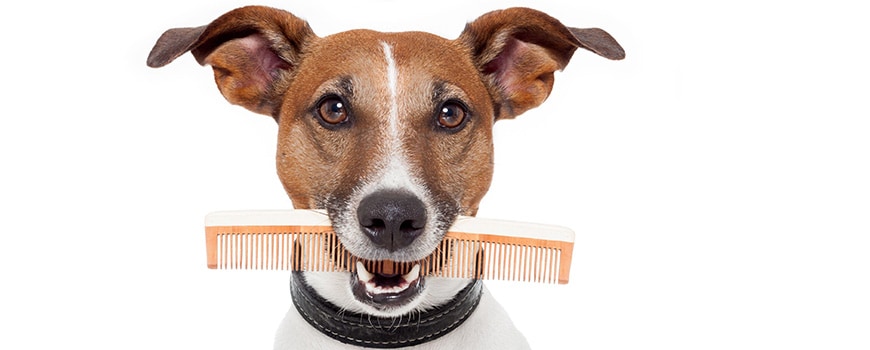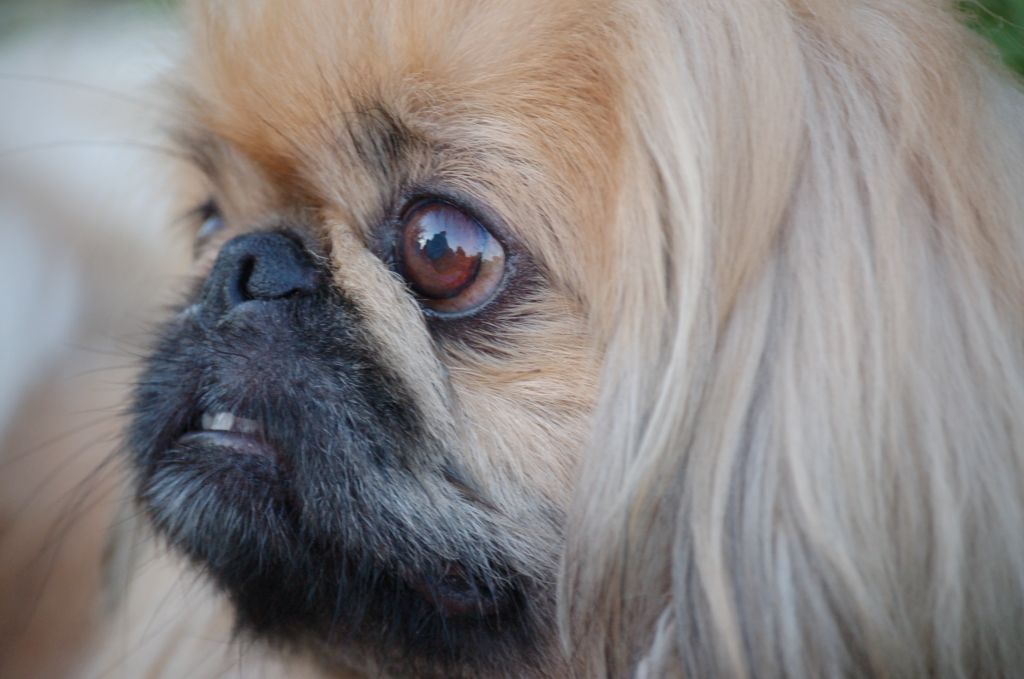The Pekingese eye is subject to more problems than that of most breeds. Special care must be taken to prevent and treat corneal abrasions. Even the Peke’s own hair can be an irritant, and long hair should never be allowed to hang over his eyes.
The hair of the over-nose wrinkle can grow into the eye unless it is trained daily by pressing the hair of the wrinkle together, or by very carefully snipping it shorter with blunt-nosed scissors.
Corneal Abrasions
These are more common in dogs with bulging eyes, and Pekingese from today’s better breeders have less bulgy eyes than typical poorly bred Pekingese do. But in any Peke, corneal abrasions can occur. Blinking, tearing, or an aversion to bright light are all signs of discomfort.
Examine the cornea (the clear outer surface of the eye) for minute indentations, scratches, or discolored areas that are the early signs of corneal ulcerations. If an ulceration is neglected, the entire cornea can turn whitish in a very short time, and permanent scarring of the cornea can occur even after the eye heals.
Pigment granules can appear in the scarred areas and proliferate. In a condition called pannus, the cornea becomes progressively covered with pigment or blood vessels, sometimes to the point that the dog becomes completely blind.
Treatment
 This should be under a veterinarian’s supervision. As a first step, you can flood the eye with sterile saline solution (such as that available for contact lens wearers) and apply an ophthalmic ointment. Keep the dog out of bright light and prevent him from pawing his eye.
This should be under a veterinarian’s supervision. As a first step, you can flood the eye with sterile saline solution (such as that available for contact lens wearers) and apply an ophthalmic ointment. Keep the dog out of bright light and prevent him from pawing his eye.
An Elizabethan collar is available from your veterinarian that will prevent your dog from reaching his head with his feet. If your dog has dewclaws, you can wrap self-clinging tape (such as Vet-Wrap) around the dog’s wrist.
Eyelid Anomalies
Sustained tearing of the eye could be due to eyelid anomalies that irritate the cornea; if ignored, they could injure the eye to the point of causing blindness.
Examine your Pekingese’s eye with a magnifying glass to see if any lashes or hairs from the over-nose wrinkle are turned inward toward the eye (trichiasis), or if there is an abnormal row of lashes (distichiasis, most often on the outer half of the upper lid), or if there is a hair growing from the caruncle, or if the lid itself turns in into the eye (entropionmost often in the middle of the lower lid).
These are all serious conditions that may require surgery to prevent extreme discomfort and possible blindness.
Watery Discharge
This can be a symptom of a foreign body, allergies, or a tear drainage problem. If accompanied by squinting or pawing, suspect a foreign body in the eye. Examine under the lids and flood the eye with saline solution, or use a moist cotton swab to remove any debris.
A clogged tear drainage duct can cause the tears to drain into the face, rather than the normal drainage through the nose. In some Pekingese, the duct may be abnormally small or not present at all. Your veterinarian can diagnose a drainage problem with a simple test.
KCS
A thick ropey mucus or crusty discharge suggests conjunctivitis or dry eye (keratoconjunctivitis sicca, or KCS). In KCS there is inadequate tear production, resulting in irritation to the surface of the eye whenever the dog blinks. The surface of the eye may appear dull.
KCS can cause secondary bacterial infection or corneal ulcers. In fact, KCS should be suspected in any dog in which recurrent corneal ulceration or conjunctivitis is a problem.
In past years, treatment of KCS was with the frequent application of artificial tears, which most owners found difficult to perform as often as needed. Recent drug advances treat the causes of KCS with ophthalmic immunosuppressive therapy.
This therapy can be quite effective if begun early enough, but if you wait until the deeper layers of the cornea are affected, there may be irreversible damage. Therefore, it is imperative that you seek veterinary attention when your Pekingese has symptoms of KCS.
Lens Problems
As your Peke ages, it is natural that the lens of the eye becomes a little hazy. You will notice this as a slightly grayish appearance behind the pupils. But if this occurs at a young age, or if the lens looks white or opaque, ask your veterinarian to check your Peke for cataracts.
In cataracts, the lens becomes so opaque that light can no longer reach the retina; as in humans, the lens can be surgically replaced with an artificial lens.
Prolapse
Because of the Peke’s relatively large eyes and shallow eye sockets, it is entirely possible for prolapse of the eye to occur, in which the eyeball actually pops out of the socket in response to a blow to the head. This is obviously an emergency that requires immediate veterinary attention if there is to be any hope of saving the dog’s vision.
Sometimes the eye will slide back if you pull the lids wide apart, but the more you handle the lids and eye, the more the area will swell, and the more you risk injuring the eye. If it doesn’t work with the first try, cover the globe with a moist sponge and get to the veterinarian.
The dog may have to be sedated to replace the eye. Sometimes the eye is so injured that sight is never regained; occasionally, the eye itself must be removed. The faster treatment is obtained, the better the chance of recovery.
Pupils
Any time your dog’s pupils do not react to light, or when one eye reacts differently from another, take it to the veterinarian immediately. It could indicate a serious ocular or neurological problem.


